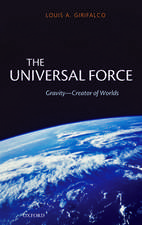Quantum Mechanics in the Geometry of Space-Time: Elementary Theory: SpringerBriefs in Physics
Autor Roger Boudeten Limba Engleză Paperback – 13 iun 2011
Din seria SpringerBriefs in Physics
-
 Preț: 477.94 lei
Preț: 477.94 lei -
 Preț: 200.36 lei
Preț: 200.36 lei -
 Preț: 346.92 lei
Preț: 346.92 lei -
 Preț: 312.68 lei
Preț: 312.68 lei -
 Preț: 317.76 lei
Preț: 317.76 lei -
 Preț: 381.00 lei
Preț: 381.00 lei -
 Preț: 311.69 lei
Preț: 311.69 lei -
 Preț: 387.25 lei
Preț: 387.25 lei -
 Preț: 380.07 lei
Preț: 380.07 lei - 17%
 Preț: 359.22 lei
Preț: 359.22 lei -
 Preț: 477.72 lei
Preț: 477.72 lei -
 Preț: 379.86 lei
Preț: 379.86 lei -
 Preț: 378.92 lei
Preț: 378.92 lei -
 Preț: 378.92 lei
Preț: 378.92 lei - 15%
 Preț: 461.73 lei
Preț: 461.73 lei -
 Preț: 413.07 lei
Preț: 413.07 lei -
 Preț: 377.18 lei
Preț: 377.18 lei - 15%
 Preț: 463.85 lei
Preț: 463.85 lei -
 Preț: 376.59 lei
Preț: 376.59 lei -
 Preț: 344.53 lei
Preț: 344.53 lei - 15%
 Preț: 462.70 lei
Preț: 462.70 lei -
 Preț: 475.06 lei
Preț: 475.06 lei -
 Preț: 377.73 lei
Preț: 377.73 lei -
 Preț: 345.89 lei
Preț: 345.89 lei -
 Preț: 378.12 lei
Preț: 378.12 lei - 15%
 Preț: 464.18 lei
Preț: 464.18 lei -
 Preț: 376.80 lei
Preț: 376.80 lei -
 Preț: 409.43 lei
Preț: 409.43 lei -
 Preț: 407.67 lei
Preț: 407.67 lei -
 Preț: 377.57 lei
Preț: 377.57 lei -
 Preț: 380.84 lei
Preț: 380.84 lei - 20%
 Preț: 387.06 lei
Preț: 387.06 lei -
 Preț: 377.73 lei
Preț: 377.73 lei - 15%
 Preț: 460.57 lei
Preț: 460.57 lei -
 Preț: 346.23 lei
Preț: 346.23 lei -
 Preț: 343.72 lei
Preț: 343.72 lei -
 Preț: 349.80 lei
Preț: 349.80 lei - 15%
 Preț: 463.53 lei
Preț: 463.53 lei -
 Preț: 376.04 lei
Preț: 376.04 lei -
 Preț: 376.80 lei
Preț: 376.80 lei -
 Preț: 475.65 lei
Preț: 475.65 lei -
 Preț: 375.07 lei
Preț: 375.07 lei -
 Preț: 376.22 lei
Preț: 376.22 lei -
 Preț: 376.80 lei
Preț: 376.80 lei - 15%
 Preț: 462.38 lei
Preț: 462.38 lei -
 Preț: 346.27 lei
Preț: 346.27 lei -
 Preț: 450.33 lei
Preț: 450.33 lei -
 Preț: 376.22 lei
Preț: 376.22 lei
Preț: 380.07 lei
Nou
Puncte Express: 570
Preț estimativ în valută:
72.73€ • 77.77$ • 60.64£
72.73€ • 77.77$ • 60.64£
Carte tipărită la comandă
Livrare economică 17 aprilie-01 mai
Preluare comenzi: 021 569.72.76
Specificații
ISBN-13: 9783642191985
ISBN-10: 3642191983
Pagini: 119
Ilustrații: XII, 119 p.
Dimensiuni: 155 x 235 x 8 mm
Greutate: 0.23 kg
Ediția:2011
Editura: Springer Berlin, Heidelberg
Colecția Springer
Seria SpringerBriefs in Physics
Locul publicării:Berlin, Heidelberg, Germany
ISBN-10: 3642191983
Pagini: 119
Ilustrații: XII, 119 p.
Dimensiuni: 155 x 235 x 8 mm
Greutate: 0.23 kg
Ediția:2011
Editura: Springer Berlin, Heidelberg
Colecția Springer
Seria SpringerBriefs in Physics
Locul publicării:Berlin, Heidelberg, Germany
Public țintă
ResearchCuprins
Introduction.- Comparison between Complex and Real Algebraic Languages.- The Clifford Algebra Associated with the Minkowski Space-Time M.- Comparison between Real and Complex Languages.- The U(1) Gauge in Complex and Real Languages - Geometrical Properties and Relation with the Spin and the Energy of a Particle of Spin 1/2.- Geometrical Properties of the U(1) Gauge.- Relation between the U(1) Gauge, the Spin and the Energyof a Particle of Spin 1/2.- Geometrical Properties of the Dirac Theory of the Electron.- The Dirac Theory of the Electron in the Real Language.- The Invariant Form of the Dirac Equation and Invariant Properties of the Dirac Theory.- The U(2) Gauge and the Yang-Mills Theory in Complex and Real Languages.- Geometrical Properties of the SU(2) _ U(1) Gauge.- The Glashow-Salam-Weinberg Electroweak Theory.- The Electroweak Theory in STA. Global Presentation.- The Electroweak Theory in STA. Local Presentation.- On a Change of SU(3) into Three SU(2)XU(1).- A Change of SU(3) into Three SU(2)_U(1).
Recenzii
From the reviews:
“This textbook addresses graduate students and researchers interested in quantum mechanics. … The author creates a very readable and well-accessible account of this new approach to quantum mechanics. … The basic endeavor of the book is a full translation of quantum mechanics into the real and invariant language of the Clifford algebra of space-time.” (Eckhard M. S. Hitzer, Mathematical Reviews, Issue 2012 m)
“This textbook addresses graduate students and researchers interested in quantum mechanics. … The author creates a very readable and well-accessible account of this new approach to quantum mechanics. … The basic endeavor of the book is a full translation of quantum mechanics into the real and invariant language of the Clifford algebra of space-time.” (Eckhard M. S. Hitzer, Mathematical Reviews, Issue 2012 m)
Textul de pe ultima copertă
This book continues the fundamental work of Arnold Sommerfeld and David Hestenes formulating theoretical physics in terms of Minkowski space-time geometry. We see how the standard matrix version of the Dirac equation can be reformulated in terms of a real space-time algebra, thus revealing a geometric meaning for the “number i” in quantum mechanics. Next, it is examined in some detail how electroweak theory can be integrated into the Dirac theory and this way interpreted in terms of space-time geometry. Finally, some implications for quantum electrodynamics are considered.The presentation of real quantum electromagnetism is expressed in an addendum. The book covers both the use of the complex and the real languages and allows the reader acquainted with the first language to make a step by step translation to the second one.
Caracteristici
Represents the most complete treatment of relativistic quantum mechanics in terms of real spacetime algebra Demonstrates practical advantages of STA theory Shows how to incorporate electroweak theory and gives novel insight into calculation of the Lamb shift, one of the pivotal problems in relativistic quantum theory

















